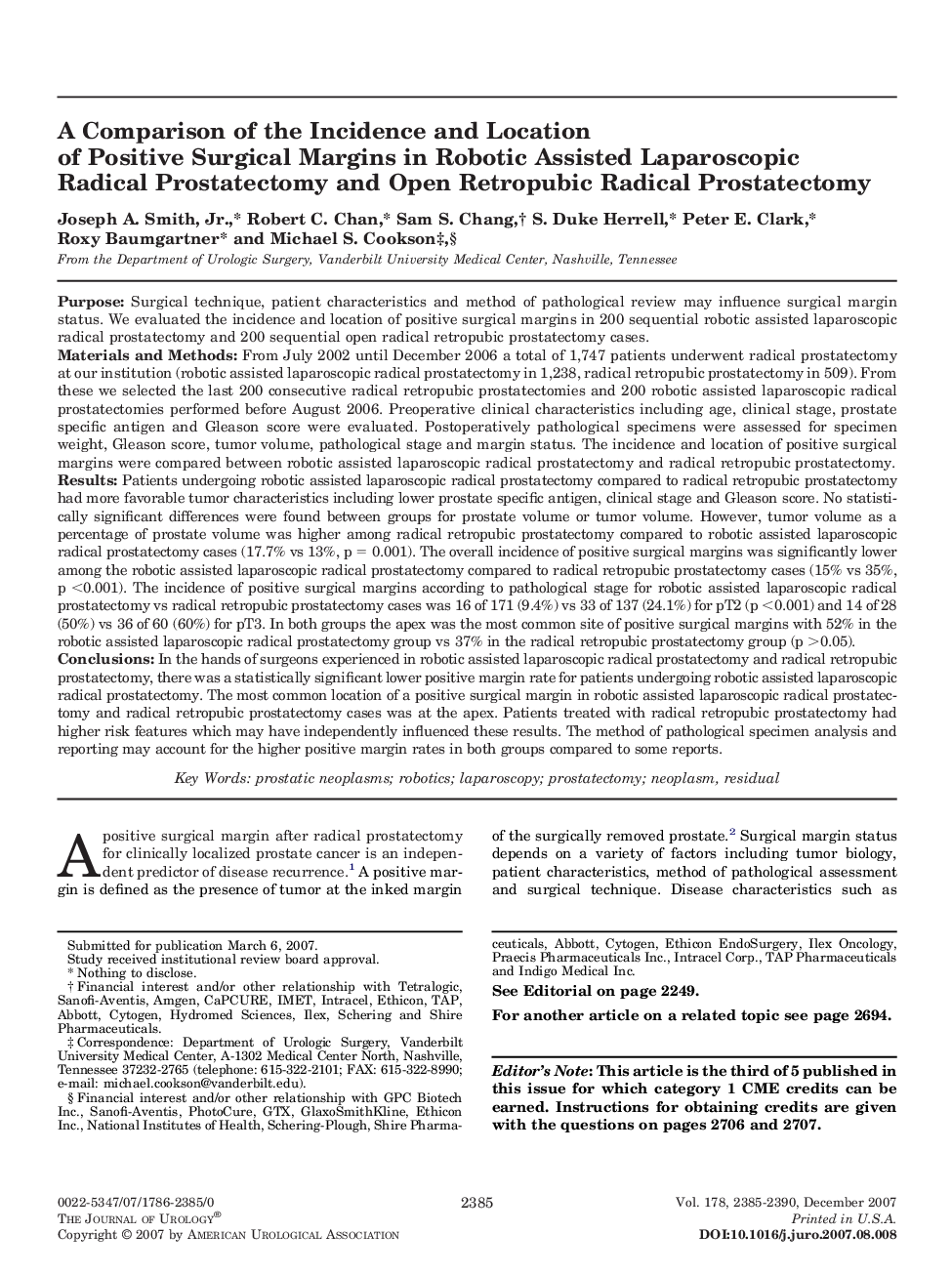| کد مقاله | کد نشریه | سال انتشار | مقاله انگلیسی | نسخه تمام متن |
|---|---|---|---|---|
| 3873342 | 1599000 | 2007 | 6 صفحه PDF | دانلود رایگان |

PurposeSurgical technique, patient characteristics and method of pathological review may influence surgical margin status. We evaluated the incidence and location of positive surgical margins in 200 sequential robotic assisted laparoscopic radical prostatectomy and 200 sequential open radical retropubic prostatectomy cases.Materials and MethodsFrom July 2002 until December 2006 a total of 1,747 patients underwent radical prostatectomy at our institution (robotic assisted laparoscopic radical prostatectomy in 1,238, radical retropubic prostatectomy in 509). From these we selected the last 200 consecutive radical retropubic prostatectomies and 200 robotic assisted laparoscopic radical prostatectomies performed before August 2006. Preoperative clinical characteristics including age, clinical stage, prostate specific antigen and Gleason score were evaluated. Postoperatively pathological specimens were assessed for specimen weight, Gleason score, tumor volume, pathological stage and margin status. The incidence and location of positive surgical margins were compared between robotic assisted laparoscopic radical prostatectomy and radical retropubic prostatectomy.ResultsPatients undergoing robotic assisted laparoscopic radical prostatectomy compared to radical retropubic prostatectomy had more favorable tumor characteristics including lower prostate specific antigen, clinical stage and Gleason score. No statistically significant differences were found between groups for prostate volume or tumor volume. However, tumor volume as a percentage of prostate volume was higher among radical retropubic prostatectomy compared to robotic assisted laparoscopic radical prostatectomy cases (17.7% vs 13%, p = 0.001). The overall incidence of positive surgical margins was significantly lower among the robotic assisted laparoscopic radical prostatectomy compared to radical retropubic prostatectomy cases (15% vs 35%, p <0.001). The incidence of positive surgical margins according to pathological stage for robotic assisted laparoscopic radical prostatectomy vs radical retropubic prostatectomy cases was 16 of 171 (9.4%) vs 33 of 137 (24.1%) for pT2 (p <0.001) and 14 of 28 (50%) vs 36 of 60 (60%) for pT3. In both groups the apex was the most common site of positive surgical margins with 52% in the robotic assisted laparoscopic radical prostatectomy group vs 37% in the radical retropubic prostatectomy group (p >0.05).ConclusionsIn the hands of surgeons experienced in robotic assisted laparoscopic radical prostatectomy and radical retropubic prostatectomy, there was a statistically significant lower positive margin rate for patients undergoing robotic assisted laparoscopic radical prostatectomy. The most common location of a positive surgical margin in robotic assisted laparoscopic radical prostatectomy and radical retropubic prostatectomy cases was at the apex. Patients treated with radical retropubic prostatectomy had higher risk features which may have independently influenced these results. The method of pathological specimen analysis and reporting may account for the higher positive margin rates in both groups compared to some reports.
Journal: The Journal of Urology - Volume 178, Issue 6, December 2007, Pages 2385–2390